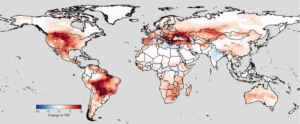
This map shows global change in a measure called “fire weather index” (FWI) predicted by the study’s analysis for the year 2045 (red: greater extreme fire weather; blue: less.) FWI captures a combination of conditions, including low rainfall and high winds, that together increase a region’s extreme fire weather condition. (Credit: NASA/Taejin Park)
If global temperatures keep rising and reach 2 degrees Celsius (3.6 degrees Fahrenheit) above pre-industrial levels, people worldwide could face multiple impacts of climate change simultaneously. This is according to a NASA-led study that analyzed the projected impacts of such warming to understand how different climate effects might combine. A 2-degree rise in global temperatures is considered a critical threshold above which dangerous and cascading effects of human-generated climate change will occur.
The researchers found that more than a quarter of the world’s population could experience an additional month of severe heat stress each year compared to the middle of the 20th century (1950-1979). High temperatures and drought could combine dangerously in places like the Amazon, increasing the risk of wildfire. In the American West, extreme fire weather will likely be more intense and last longer.
